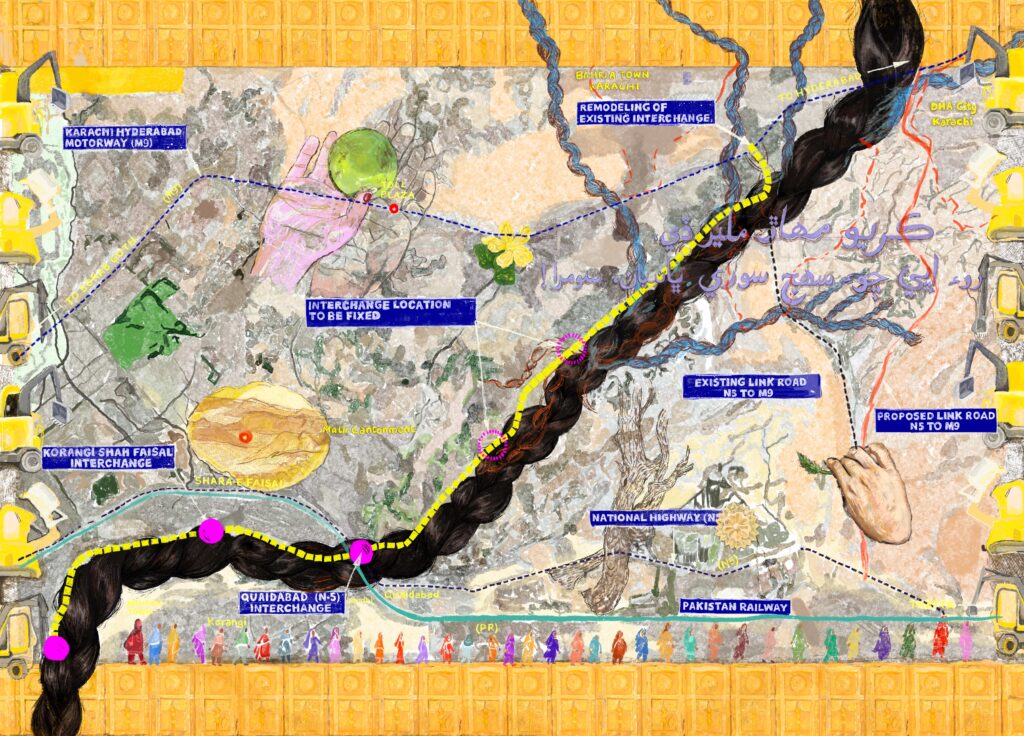How Do You Map A Braid?
ڪريو مُھاڙِ مَلِيرَ ڏي، روءِ اُڀِي چوءِ:
سُھجُ سُورِي ڀانئِيان، سُومِرا!
Turning her face toward Malir, she weeps and says: ”Oh Sumiro, I think your comforts are torments.”
– Bhittai,“Sur Marui 1:28” Shah Jo Risalo
Local Government Department (“LGD”), Government of Sindh intends to develop the Malir Expressway which will be a 4-lane dualized expressway along the Malir River from Hino Chowk near KPT Flyover to Karachi–Hyderabad Motorway (M-9) near Kathore via link road. The total length of the Malir Expressway will be 39.3 km. The proposed expressway will provide a new southern alternative route for carrying port traffic and traffic from industrial areas to main highways. The Expressway will provide speedy access to key real estate schemes along the route, reducing commuting time from KPT Flyover to Super highway (M-9) to only 25 minutes.
The Malir Expressway, a major infrastructure project, is currently under construction on the outskirts of Karachi, Pakistan’s largest city. This coastal metropolis thrives on its connection to water, yet the expressway cuts directly through the river basin of the historic land of Malir. Composed of numerous villages, Malir has long been subjected to “redevelopment” pressures, notably from the expansive Bahria Town housing scheme. Its predominantly Baloch and Sindhi residents proudly assert that Malir’s unique ecology has shielded Karachi from urban flooding for decades. Central to this environmental shield is the Malir River, one of Karachi’s two major seasonal waterways, whose very existence is now jeopardized by the encroaching expressway.
This counter map responds to the construction of the Malir Expressway in Karachi, Pakistan that unhouses the people of Malir as it is built. Moreover, It questions the map released by the state which proposed building the expressway over the Malir River Basin, and in doing so, defied the ecological spirit of the land. Using the Malir Expressway map as a base, my map thinks through the dotted line while considering the elements and conditions that express the genius loci of a place, something that redevelopment projects never assess or include in their surveys before they decide to remake and unmake. The dotted line often used in similar proposals absurdly signifies large scale interventions in the land while maintaining a temporal quality on paper. This trace is juxtaposed with the braid river of the map and dotted with moments that the cartographer experiences with the land as they walk along the river basin, picking up fruit, looking at unclassified heritage sites and touching the trees that will cease to exist as the project is carried forward.
Dashed lines, solid lines, ones with dashes and dots, thick ones, thin ones… What do all these lines mean?
A weak line of dots. Do they number more than the houses demolished, or less?
Malir River in Balochi means ‘braid’. In the indigenous language of Malir, the river is imagined as hair that is twisted in patterns, unfolding and folding, leading to different routes and paths, not as a single entity but a plural form. As hair sticks out of a neat braid so do the tributaries and channels that come out of Malir.
Is that line of dots enough to contain the river braid of Malir?
(What kind of line is a braid?)
(What kind of river is a braid?)
The braid arrives and enters the map of the expressway along with the bodies destabilized, heritage erased, and the ecology of Malir disrupts the map and utters its reply. Just as Marvi, the village girl, responds to Soomro, ruler of Umerkot, as she rejects the palace and longs for her land. Marvi’s story comes from Shah Abdul Latif Bhittai’s seminal work ‘Shah Jo Risalo’, the renowned tale of Umar and Marvi. Marvi was kidnapped by Umar, a prince, who tried to entice her with promises of jewels and a life of luxury. The story is about Marvi’s resistance and her desire to return to her land of Malir. For Marvi, the soil she came from was more important than any extravagance Umar could provide. The resistance that the people of today’s Malir have maintained against the expressway is similar in spirit. Despite the promises of ease and progress that the expressway promises for the city of Karachi, the people of Malir continue to fight for their land and soil, rejecting what the state defines as ‘progress.’
